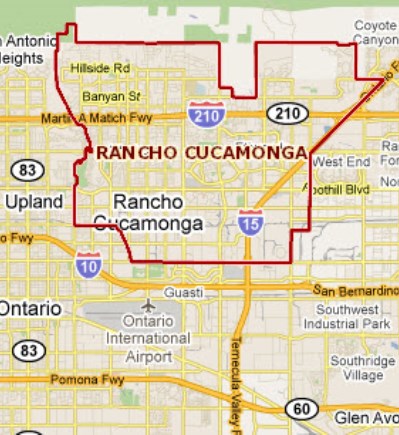The city wants to add more than 4,000 acres north of its border. Some residents are less than thrilled with the idea.
Rancho Cucamonga is trying to become larger. About six square miles larger, to be precise.
The city wants to annex approximately 4,100 acres of land north of its border, much of which is owned by the San Bernardino County Flood Control District.
That land, which the district has said it no longer needs, is mostly north of the Foothill Freeway and east of Haven Avenue. That puts it within Rancho Cucamonga’s sphere of influence, making it easier to bring within the city’s borders.
The Rancho Cucamonga City Council has directed staff to study possible commercial and residential development on about 1,200 acres on the southern end of the property.
While the county would still own the land, annexing it would place it under the jurisdiction of the city, giving Rancho Cucamonga more say in what’s developed there, said Matt Burris, deputy city manager.
But some residents are concerned about any development in an area that is largely pristine. They believe what is being proposed is too dense and would add to the city’s traffic and air quality problems.
“I go almost everywhere in the city, and the traffic is terrible,” said Joseph Cowan, a Rancho Cucamonga resident for more than 50 years. “During rush hour it’s almost impossible to move around, and this would make things worse. We can’t handle the extra population.”
Opposition to the project grew late last year, during four community meetings and several online events. A Facebook page, “Stop Rancho Cucamonga Expansion,” was started.
In response, staff put together a list of frequently asked questions, with answers, to update and clarify the proposed annexation’s status.
One clarification: The city has an agreement with Sargent Town Planning, an urban consulting firm in Los Angeles, to prepare a specific plan for the annexation area. Sargent Town has also arranged for completion of an environmental impact report.
The two-page question-and-answer document, which was released early this month, also makes clear that the annexation is not a done deal.
The specific plan and environmental report, both of which are required to complete the process, have barely gotten started, and development rights for areas within the site must be determined.
Also, once the city agrees on a final plan, it must be approved by the state Associations of Local Agency Formation Commissions in Sacramento, which has final say regarding annexations.
Rancho Cucamonga officials have already revised their plans based on the opposition raised during the community meetings last year, Burris said.
Plans for multifamily housing and an urban village have been dropped, and the city no longer plans to put office buildings in the annexation site. Most of that land is open space, but it has some development, including a few single-family residences, the Ling Yen Mountain Temple and several Southern California Edison transmission lines.
Now, city officials are studying plans to possibly develop more single-family homes, and possibly some light retail, on the site, but not much more. The amount of development there could be scaled back to 900 acres, according to Burris.
“There was a lot of concern about the amount of development we were proposing,” Burris said. “A lot of people thought it was too dense, and we understand where they’re coming from. It’s their community, and they expect to have some say in how that property is developed.
“We’re still going to do the annexation. The question now is how will we develop it once we do annex it.”
Rancho Cucamonga officials have been considering annexing the land – the project’s official name is the North Eastern Sphere Annexation Project – since 2005, when the flood control district began negotiating with developers about selling the property.
No deal was reached, opening the door to annexation, which the city wants because it wants any development there to be subject to its zoning laws and other regulations.
“What’s developed there now isn’t as important as having control of that property,” Burris said. “We don’t want something going in there that we don’t like, so we have to come up with a plan. If the county were to decide to leave it vacant, that would be fine with us.”
Some opposition to the planned annexation goes deeper than concerns about traffic and dirty air, Cowan said.
Rancho Cucamonga has its share of horse owners, and parts of the annexation area permits houses where people may keep horses.
“One of our big issues is keeping that equestrian overlay,” said Cowan, president of the Alta Loma Riding Club. “The city’s general plan allows for half-acre [residential] lots for horse ownership, and we’d like to see it stay that way.”
City officials are planning to hold at least two more public meetings, one in March and another in April, along with more online forums, Burris said.
Council members should receive a final proposal in May, and a final environmental impact report could be ready by January.
Without annexation, the land would go back to the county, at which point it would have to resume negotiations with a developer for a possible sale.
“Neither side wants that to happen,” Burris said.
 IE Business Daily Business news for the Inland Empire.
IE Business Daily Business news for the Inland Empire.


